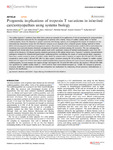Mostrar o rexistro simple do ítem
Prognostic Implications of Troponin T Variations in Inherited Cardiomyopathies Using Systems Biology
| dc.contributor.author | Shakur, Rameen | |
| dc.contributor.author | Ochoa Folmer, Juan Pablo | |
| dc.contributor.author | Robinson, Alan J. | |
| dc.contributor.author | Niroula, Abhishek | |
| dc.contributor.author | Chandran, Aneesh | |
| dc.contributor.author | Rahman, Taufiq | |
| dc.contributor.author | Vihinen, Mauno | |
| dc.contributor.author | Monserrat, Lorenzo | |
| dc.date.accessioned | 2021-09-27T11:51:06Z | |
| dc.date.available | 2021-09-27T11:51:06Z | |
| dc.date.issued | 2021-06-14 | |
| dc.identifier.citation | Shakur, R., Ochoa, J.P., Robinson, A.J. et al. Prognostic implications of troponin T variations in inherited cardiomyopathies using systems biology. npj Genom. Med. 6, 47 (2021). https://doi.org/10.1038/s41525-021-00204-w | es_ES |
| dc.identifier.issn | 2056-7944 | |
| dc.identifier.uri | http://hdl.handle.net/2183/28517 | |
| dc.description.abstract | [Abstract] The cardiac troponin T variations have often been used as an example of the application of clinical genotyping for prognostication and risk stratification measures for the management of patients with a family history of sudden cardiac death or familial cardiomyopathy. Given the disparity in patient outcomes and therapy options, we investigated the impact of variations on the intermolecular interactions across the thin filament complex as an example of an unbiased systems biology method to better define clinical prognosis to aid future management options. We present a novel unbiased dynamic model to define and analyse the functional, structural and physico-chemical consequences of genetic variations among the troponins. This was subsequently integrated with clinical data from accessible global multi-centre systematic reviews of familial cardiomyopathy cases from 106 articles of the literature: 136 disease-causing variations pertaining to 981 global clinical cases. Troponin T variations showed distinct pathogenic hotspots for dilated and hypertrophic cardiomyopathies; considering the causes of cardiovascular death separately, there was a worse survival in terms of sudden cardiac death for patients with a variation at regions 90–129 and 130–179 when compared to amino acids 1–89 and 200–288. Our data support variations among 90–130 as being a hotspot for sudden cardiac death and the region 131–179 for heart failure death/transplantation outcomes wherein the most common phenotype was dilated cardiomyopathy. Survival analysis into regions of high risk (regions 90–129 and 130–180) and low risk (regions 1–89 and 200–288) was significant for sudden cardiac death (p = 0.011) and for heart failure death/transplant (p = 0.028). Our integrative genomic, structural, model from genotype to clinical data integration has implications for enhancing clinical genomics methodologies to improve risk stratification. | es_ES |
| dc.description.sponsorship | Medical Research Council (UK); MC_U105674181 | es_ES |
| dc.description.sponsorship | R.S. was supported by an independent Wellcome Trust Fellowship. A.J.R. was supported by the Medical Research Council UK (MC_U105674181). A.C. was funded by the Newton Fellowship from the Royal Society, UK. M.V. was supported from Vetenskapsrådet. | |
| dc.language.iso | eng | es_ES |
| dc.publisher | Nature | es_ES |
| dc.relation.uri | https://doi.org/10.1038/s41525-021-00204-w | es_ES |
| dc.rights | Atribución 4.0 Internacional (CC BY 4.0) | es_ES |
| dc.rights.uri | https://creativecommons.org/licenses/by/4.0/ | * |
| dc.title | Prognostic Implications of Troponin T Variations in Inherited Cardiomyopathies Using Systems Biology | es_ES |
| dc.type | info:eu-repo/semantics/article | es_ES |
| dc.rights.access | info:eu-repo/semantics/openAccess | es_ES |
| UDC.journalTitle | Genomic Medicine | es_ES |
| UDC.volume | 6 | es_ES |
| UDC.issue | 1 | es_ES |
| UDC.startPage | 47 | es_ES |
| dc.identifier.doi | 10.1038/s41525-021-00204-w |
Ficheiros no ítem
Este ítem aparece na(s) seguinte(s) colección(s)
-
II - Artigos [690]








